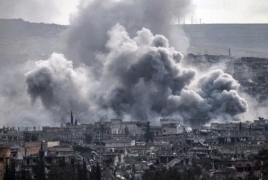Islamic State leaders fleeing Raqqa - U.S. military March 9, 2017 - 13:04 AMT PanARMENIAN.Net - As Syrian fighters backed by the United States close in on Raqqa, some of the Islamic State’s leaders have fled their self-declared capital and are planning to carry on the fight from other sanctuaries in Syria and Iraq, The New York Times cited an American defense official as saying on Wednesday, March 8. The departure of some of the group’s leadership does not mean that the battle to take Raqqa will be easy, the official said. An estimated 3,000 to 4,000 fighters remain in the city. To provide more firepower for the looming battle, a United States Marine artillery unit is being deployed in Syria, mimicking the approach the United States has taken to support Iraqi troops fighting to reclaim Mosul from the Islamic State, also known as ISIS or ISIL. A detailed assessment of Islamic State fighting capabilities was provided by the American defense official, who could not be identified under the ground rules for the Pentagon briefing. The overall picture the official painted of the Islamic State was of an organization losing significant amounts of territory but still determined to fight. All told, the militant group is estimated to have at least 15,000 fighters in Iraq and Syria, although its flow of volunteers has shrunk to 100 a month or even fewer. No more than 2,500 fighters are struggling to defend western Mosul and the nearby town of Tal Afar, where they are largely cut off by Iraqi forces from receiving supplies and reinforcements. Those fighters have used crude chemical weapons, including chlorine and low-grade sulfur mustard. But while the weapons have hurt civilians, American officials do not believe that they have been militarily effective. The American-led command has concentrated on striking midlevel commanders to try to sow confusion in the Islamic State’s ranks. The official said the group had lost 65 percent of the terrain that it controlled in Syria and Iraq at its peak. Still, the official acknowledged, the Islamic State has the resources to carry on, including an abundant supply of weapons and cash that it stole from the Iraqi and Syrian authorities when the militant group swept across the countries in 2014. The resilience of Abu Bakr al-Baghdadi, the group’s leader, may also be a rallying factor. The American defense official said he was believed to be alive and to have left Mosul. American officials appear confident that the Islamic State will be evicted from Iraq’s major cities and towns within six months. One militant stronghold that the Iraqi government has yet to focus on is Hawija, west of Kirkuk. Iraqi troops bypassed the town, where the defense official said the Islamic State has as many as 1,000 fighters, in the rush to reach Mosul. In October, the militant group used the Hawija area as a springboard for a counterattack on Kirkuk, which was put down after a couple of days of bitter fighting. The Islamic State has suffered the loss of Al Bab in northern Syria, which fell to Turkish forces and Turkish-backed Syrian militias on Feb. 23. The militants had used the town as a command center and relied on the network of roads there to distribute fighters and supplies. Azerbaijani authorities report that they have already resettled 3,000 people in the Nagorno-Karabakh town of Stepanakert. On June 10, Azerbaijani President of Azerbaijan Ilham Aliyev will leave for Turkey on a working visit. Azerbaijani President Ilham Aliyev arrived in Moscow on April 22 to hold talks with Russian counterpart Vladimir Putin. Authorities said a total of 192 Azerbaijani troops were killed and 511 were wounded during Azerbaijan’s offensive. Partner news |